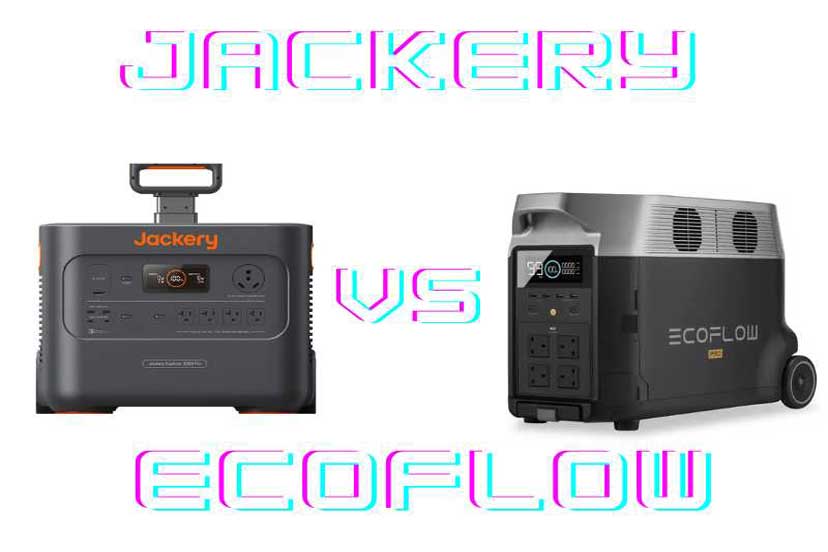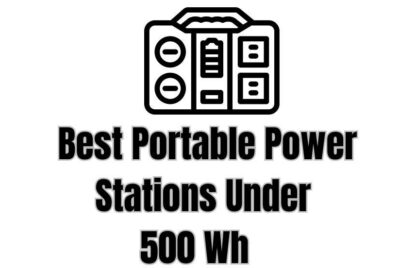Jackery versus Ecoflow: Comparing 2024’s Top Solar Generators
I may earn a commission for purchases made through my links. It helps me run this site. Check out my disclosure for more details.
I’m pitting two of the heavyweights against one another in this solar generator/portable power station showdown, with the main event featuring Jackery versus Ecoflow. You’ll find a few like-for-like model comparisons, as each manufacturer has so many models to choose from, and you can find separate reviews for many of them across this site.
Jackery is the most popular of the two brands, being born and manufactured in the USA. The concept of Ecoflow grew from Shenzhen, China, which has been at the forefront of providing the world’s battery and electronics technologies for decades. In 2012, Jackery started out in California on a humble mission to provide green technological power solutions, catering to the outdoor market. (One of the reasons they have built-in LED lights). Power stations without solar panels were produced and aimed squarely at the camping and RV market, and for anyone who wanted to bring a power supply outside that didn’t run on gas or diesel.
A few years later, Jackery invented the first portable solar panel and completely revolutionized the alternative portable power station market overnight. They were the original trailblazers. That’s why today there are so many power stations on the market, but Jackery, being the first, is still leading the way.
The Jackery Range
Jackery makes power stations from 160 right up to 3000 watt hours. Jackery does not offer that many expandable options, whilst Ecoflow has several models that allow expansion by adding extra SMART batteries. Jackery does have the unique 2000 Plus power station which is designed with complete home backup integration in mind, and can be expanded right up to 24kWh, by daisy chaining multiple power stations together. But Ecoflow are more versatile and allows you to do this with multiple products in their line-up.
EcoFlow also makes complete Power Kits designed for powering small homes and RVs with a capacity of up to 16 kWh. The price tag is just under $17K, and they can be charged 4 ways. You may have seen the advert featuring the “Simple, Smart, Compact” catchphrase. These are complete custom-spec off-grid systems that incorporate stackable batteries, a control panel, solar panels, 2 MPPT solar chargers, an inverter & charger, plus CC chargers and converters. They can be charged with solar, grid, RV alternator, and generator power.
Nice Touches From Jackery
Jackery supplies a nice pouch to house its accessories (power cord/cables) whereas EcoFlow supplies them in a packaged box, which is not really useful for carrying or storing when you are traveling or going off-grid. You’ll just probably throw it in the trash, where you can actually keep Jackery’s pouch for future use.
If you’re liking Jackery, there’s a complete run-through of the entire Jackery solar generator range here.
Ecoflow Hits Heavier From The Ground Up
EcoFlow come in heavier hitting than Jackery at the lower end of the scale and provide faster charging times, much longer battery cycle life, and more outlets on their entry-level power stations. They come out all guns blazing with power and don’t lumber you with low-level batterries at the bargain end of the market.
Ecoflow makes two product lines: the smaller River Series and the larger capacity Delta Series. Even their entry-level River series products feature high-spec fast-charging batteries.
For a run-down of the entire Ecoflow solar generator range check out this post.
Budget Babes – EcoFlow River Mini Vs Jackery 240
This section will draw comparisons between Jackery and Ecoflow’s entry-level products, the Jackery 240 and the Ecoflow 160.
If comparing like for like, the Jackery Explorer 240 has a similar range of power to that of the Ecoflow’s River Mini. So starting with Ecoflow, the 210Wh River Mini can be charged to 80% in an hour and has 2 AC wall outlets, 4 USB ports, and a DC car connection.
It even has a wireless charging pad on the top. It can output 300W continuously and has a peak surge of 600W (for those devices that take a little extra power just to get started). Like the 240 from Jackery, the battery is good for 500 life cycles before it starts to lose about 20%. Use it casually, and it’ll run for 5 years; use it more often, and you’ll get about 2 years before the battery drops.
For an entry-level power station to have such high-end technology at the low end of the market is simply outstanding. It can be fully charged with AC power in 90 minutes. Car charging takes 3.5 hours, and solar between 3-6 hours (depending on how strong the sun is) with 100W of solar input.
*with a 100W solar panel the EcoFlow solar generator kit works out cheaper than the Jackery 240 Explorer kit*
Jackery’s 240 has slightly more battery capacity, coming in at 240Wh. It has a smaller surge of 400W and has 1 x AC outlet, and 3 x USB ports. AC charging takes a much longer 5.5 hours; Solar input is the same at 100W and takes roughly the same time as the River Mini, coming in at about 5.5 hours; and it takes longer to charge via a car connection, at 6.5 hours.
The River Mini certainly edges it with more connection ports, including the advanced wireless charging pad, faster wall and car charging, and a higher peak surge capacity. In terms of acting as solar generators, they really are neck and neck, as they take roughly the same length of time to charge.
The 240 is certainly more popular and has lots more reviews on Amazon, because people love Jackery. Perhaps it is the black and orange colors that make it stand out, their marketing, or the fact that they are a home-grown brand. I personally love both, and to me, the River edges it in the design department, has better stats, and is also usually cheaper to buy. It’s hard to purchase, though, from EcoFlow; it’s usually out of stock, so perhaps it will soon be discontinued. It is available on Amazon, though, as I write this.
If you want really cheap, check out this post on the 7 best portable power stations under $200.
The Jackery 240 solar generator kit includes a 100-watt solar panel and is keenly priced.
EcoFlow River Mini & Jackery 240 Visual Comparison
They are neck-to-neck with solar charging, but the Ecoflow River comes out on top with superior AC charging, a higher peak rating, and longer battery life, not by much, but it still counts. The River also has more connection ports. So at the lower end of the power scale, EcoFlow comes out on top.
| Feature | River Mini | Jackery 240 |
|---|---|---|
| Capacity | 210Wh | 240Wh |
| Power Output | 300W Pure Sine Wave Continuous, 600 Surge | 300W Pure Sine Wave Continuous, 400 Surge |
| Battery Life | 500 cycles to 80+% | 500 cycles to 70+% |
| Dimensions | 9.8 x 5.5 x 5.2 inches | 9.05 x 5,24 x 7.87 inches |
| Charging time | AC Outlet 1.5 hours, Solar with 100W input 3-6 hours, Car Port 3.5 hours | AC Outlet 5.5 hours, Solar with 100W input 3-6 hours, Car Port 6.5 hours |
| Weight | 6.3 pounds | 6.6 pounds |
| USB output | 4 USB ports, 5V, up to 2.4A per port, USB-C PD 20V, up to 3.0A | 2 USB-A ports, 5V, up to 2.4A per port; 1 USB-C port, 5V-20V, up to 3A |
| Output connections | 2 AC outlets, 2 USB-A ports, 2 USB-C ports, 1 X DC Port, 1 X Wireless Charge Pad | 1 AC outlets, 2 USB-A port, 1 USB-C Ports, 1 X DC Port |
Mid-Tier Battle: Jackery 1000 Pro Vs Ecoflow Delta 2
We have reviewed the Jackery 1000 Pro here, and it’s a really capable machine.
Jackery will charge up with solar a little faster, but the Ecoflow Delta 2 has way more AC and connection ports. AC charging is also a little faster
| Feature | Jackery 1000 Pro | Ecoflow Delta 2 |
|---|---|---|
| Capacity | 1002Wh | 1000 Wh (can expand up to 3072 Wh) |
| Power Output | 1000W – 2000 Peak | 1800W – 2200 with X-Boost mode – 2700 Peak |
| Battery Life | 1000 charge cycles | LifePO4 battery – 3000 cycles to 80% |
| Dimensions | 13.39 x 10.32 x 10.06 inches | 15.7 x 8.3 x 11 inches |
| Charging time | AC: 1.8 hours, Solar: 1.8 hours (with four 200W solar panels) Car: 7.5 hours | AC: 1.2 hours Solar: 3 hours 2 x 220w panels (Max solar input is 500W) |
| Weight | 25.4 lbs | 27 lbs |
| USB output | 4 in total – 2 x USB-C Ports 2 x Quick Charge USB-A 3.0 Port | 6 in total – 2 X USB-A, 2 X Quick Charge USB-A, 2 X USB-C |
| Output connections | 3 x AC Outlets, 4 x Usb, 1 x 12V Car Outlet (8 in total) | 6 x AC Outlets, 6 x USB (14 in total) 1 x 12-24v Car Outlet, |
Current Jackery 1000 Pro price on Amazon
Current EcoFlow Delta 2 price on Amazon
Both of these battery systems offer more than the Ecoflow River & Jackery 240. They won’t provide you with a complete home grid and all-in-one off-grid energy solution, but they will deliver you some adequate stand-alone power. The Delta 2 can be expanded with an extra battery up to 2 kWh, and if you add on a Delta Max extra smart battery, your system will reach just over 3 kWh.
But apart from expandability, which Jackery doesn’t offer with the 1000 Pro, which is the better power station? If you want to run higher-powered appliances like a microwave and coffee machine, the Delta 2 is more capable than the Jackery 1000 Pro. If you are running multiple devices, the Jackery will cut out quicker, unless you unplug everything else out when you want to run a 1200-1500w coffee maker or microwave.
The Delta Pro can boost up to 2700 watts when you switch on the X-boost technology, so you won’t necessarily have to unplug everything else if you want some warm bagels or a steaming hot cup of Joe. Ecoflow definitely wins in the battery life compartment, totally whipping Jackery with 3000 life cycles as opposed to 1000.
So the wattage capacity is a lot stronger on the Delta 2, and it will run up to 90% of your household appliances, which is really outstanding for a fairly portable machine that only stands 15 inches tall. The only drawback of running refrigerators, microwaves, grills, and hairdryers with machines like these is that the batteries will drain quicker. That’s why many folks who have the money and like the portability of the Delta series will expand the batteries to cope with the extra power needs.
More Brand Head-to-Heads to read




